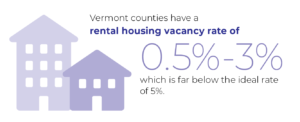Housing and Homelessness: Ensure Access to Safe, Stable, and Affordable Housing
The pandemic and the 2023 flooding illuminated and exacerbated the challenges too many Vermonters face finding and maintaining affordable housing The crisis is of particular concern for families with young children who are at risk for and are currently experiencing homelessness. Currently, 1,273 households rely on state emergency housing programs (the Pandemic Era Hotel/Motel Transition Program and the traditional General Assistance Emergency Housing Program). At least 196 of these households are families with children. The Hotel/Motel Program is set to end in April, leaving the outdated and more limited General Assistance Program as the only emergency housing option when shelter beds are not available, which will result in many Vermont households without shelter.
The Alliance supports the Housing & Homelessness Alliance of Vermont (HHAV) in its request for the Legislature to do the following:
- Make $160 million in housing capital available for affordable housing and shelter development and preservation
- Provide full statutory funding of the Vermont Housing and Conservation Board through the Property Transfer Tax
- Re-envision the state-run emergency housing system
- Ensure adequate funding for General Assistance emergency housing and households remaining after the end of the Hotel/Motel program (the June Cohort) while any programmatic changes are implemented
- Adequately fund the state programs that provide support and services for households in temporary and permanent housing, with particular attention to housing stability and retention services designed to increase sustainability and prevent homelessness for Vermont families.
LEAD ORGANIZATION: Housing and Homelessness Alliance of Vermont

Data and Talking Points
- On average, over 3700 children aged 9 and under were in households enrolled in Reach Up at one point in FFY22
- Vermont counties have a rental housing vacancy rate of 0.5% to 3% which is far below the ideal rate of 5%
